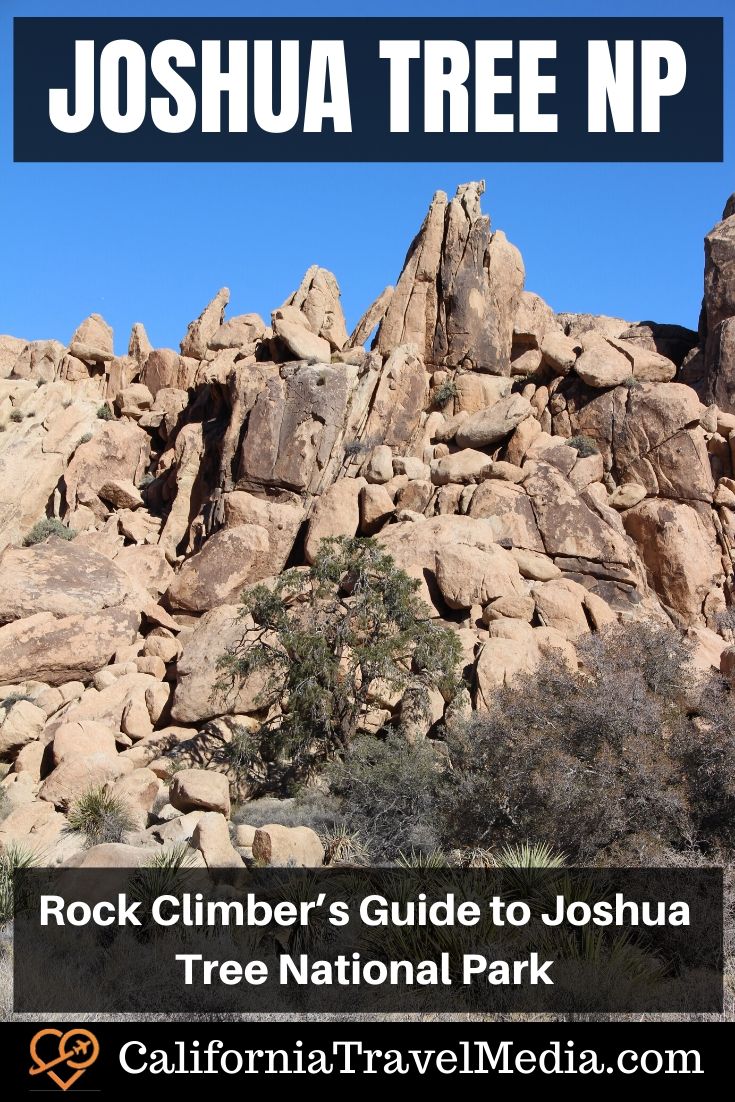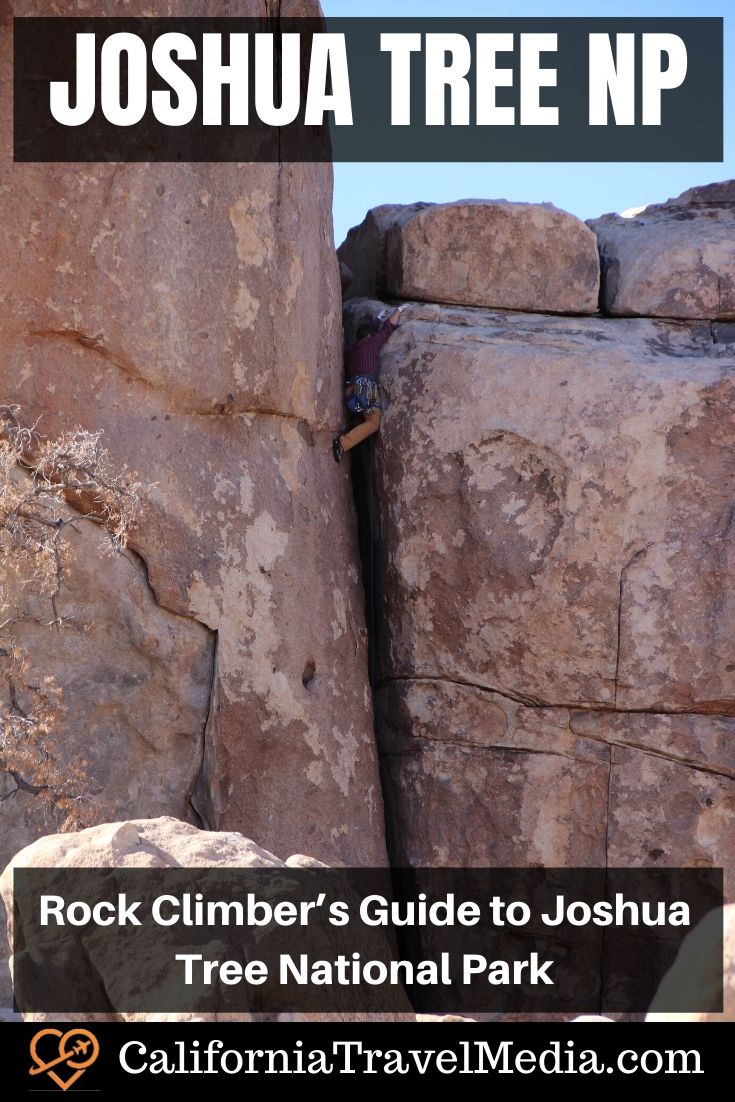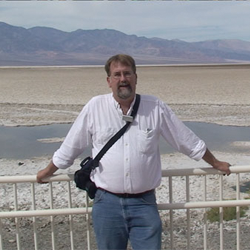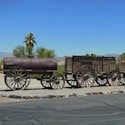Joshua Tree Rock Climbing – Rock Climber’s Guide to Joshua Tree National Park
categories: California Deserts
Few physical exercises can engage a wide range of body muscles like climbing does. Your quads, biceps, and heart all have to perform optimally as your torso and hips strain to hold the lower half of your body against a boulder. As you extend your hand to get a hold of the next grasp, your arched back, calves, and thighs begin to burn with the effort of holding a steady balance. Then you have to shift your muscles once more to keep a steady climb upwards. Now imagine that you are enjoying the quick rush of adrenaline that follows this activity while viewing one of the most panoramic sites in the United States.
The Joshua Tree National Park’s spectacular sunsets are legendary. Its car-sized boulders and wide range of spiky plants have made it America’s rock climbing and photography Mecca. This otherworldly wonderland named after the Mojave Desert’s scarecrow-esque enduring symbol, Yucca brevifolia or Joshua tree, has tons of breathtaking sights.
The park embraces both the Sonoran and Mojave deserts, two different arid ecosystems in an environment sculpted by thousands of years of strong winds and rains.  There is plenty of flora and fauna ranging from 3-foot long chuckwalla lizards to endless carpets of wildflowers. When the night comes, the park turns to a superbly clear night sky perfect for stargazers. Joshua Tree was made a National Monument in 1936 and was designated a National Park in 1994. The park’s otherworldly mishmash of beauty is also ideal for hiking, horseback riding, bird watching, plant spotting, and biking environment.
Table of contents: ()


Why Rock Climb in Joshua Tree National Park?
-
Joshua Tree National Park is a climber’s nirvana
Occupying a vast 789,745 acres of land, it has at least 8,000 climbing and hiking routes scattered all over it, the most of any other site in the U.S.
This multitude of routes in various domes, outcrops, cliffs, and formations composed of bumpy monzogranite and rough gneiss rocks are perfect for soloing, trad, sport, winter climbing, and bouldering as well.
Joshua Tree is unlike other rock-climbing spots like the Shawangunks in New York or the Yosemite Valley, where you encounter many people at the base of climbs. Here, you will only have bird songs and the solitude of your footsteps.
-
Its rock-climbing scenarios can help you improve your technique
They say that strength is vital in rock climbing, but mastering your technique is what makes you a legendary climber. The park has a wide range of rock-climbing scenarios in a variety of climbing difficulties that can help you to master your technique.
It is, therefore, the perfect area to practice those dynos, which, while considered an insane move due to its extreme need for speed and energy, once mastered, it can really impress.
You will also find spots that will need a mastery of edging, tree-laybacks, smearing, body wedging, hand jamming, slabby, and overhanging techniques to mention but just a few. There is a spot for every technique out there in this magnificent park.

-
It has breathtaking views (perfect for photography)
One other reason that should take you rock climbing at Joshua Tree is the sublime beauty of the park. Yes, coastlines are hot, but you only think so because you have not seen the park’s legendary blazing desert sunsets.
Every spot in the park has all the ingredients needed for high-end magazine photography. There is the unusual beauty of strange desert plants cropping alongside towering boulders and rock piles. Then there all types of animals ranging from rare bobcats to coyotes, bighorn sheep, and roadrunners.

-
Diverse routes
The park’s routes are so varied that there are perfect hiking and climbing routes for all ages ranging from 3 to 103 years. You’ll get ample easy to walk routes that are perfect for the whole family and beginner routes for the learners.
There are extreme rock-climbing routes that should only be used by seasoned climbers. You will, therefore, find many sport and trad climbers here.
Most Joshua Tree rock climbing routes generally fall under the elite graded climbs. But despite the challenge they impose on climbers, the rocks are not too big, so most learners can practice on them. The park’s granite boulders formed underground eons ago escaped the polishing done by glaciers.
The rock formation’s quartz, therefore, sticks out from them in small knobs giving climbing shoe rubber soles a good grip during climbing.

Where to go rock climbing in the park
The very first rock climbers in the park came in the early 70s and, as all pioneers do, began to associate names for routes. You will, for instance, hear of old routes like the Bankrupt Wall, 39 Steps, Double Dip or Campfire Girl.
Double Dip could have been named so due to the large flake of rock that pulls away from the main cliff, curving like two giant ice cream scoops.
The most common aspect of rock climbing at the park, however, is that most rock-climbing routes are at 4,000 feet above sea level. The temperatures could dip to the 30s at night and hit highs of 60 when the sun is at its fiercest.
The endless desert land is almost flat in most areas. You can see for miles on end with minimal effort until your eyes encounter the lone rocky hill.
Its beautiful flora, though attractive enough to warrant a touch, has features equivalent to those of shark teeth or desert tribe’s scimitars, so steer clear of it for an enjoyable trip.
The best beginners spots
If you are learning to climb, then go to Joshua Tree National Park. You will find a wide variety of beginner climbs sprinkled in different places in the park. You can choose to start your climb in the shade, sun, facing east, west, south, or north.
You can even ask your instructor to show you a route sheltered from the wind or panoramic climbs that will make you forget the pain of that heel hook move. There are also perfect places where, after just a few steps, you can get to enjoy the climb in the solitude you have been craving for. Some of the best Joshua Tree routes for the beginner include:
- Quail Springs Rock
- Thin Wall
- Atlantis Wall
- Intersection Rock
The best-accomplished climber’s sites
Most advanced climbers that visit Joshua Tree National Park are old-timers. Rock climbing, just like surfing, can quickly become an all-consuming passion that demands all the time a climber has.
It is the magical mix of adrenaline, physical exhaustion, the challenge of accomplishing a difficult task as well as beautiful surroundings that quickly becomes addictive. You will find the park’s most seasoned climbers at:
- Big Moe for the overhanging face climbing challenge
- Jerk, WangerBanger 5.11c or Clean perfecting steep crack climbs
- Saddle Rock or Lost Horse Wall for multi-pitch climbs
- Possessed By Elvis 5.10d, or Loose Lady 5.10a for thin-edged, vertical face climbing

Perfect climbing seasons in the park
You can enjoy rock climbing in the park at any time of the year. If you, however, visit the park between March and April or October and November, you will enjoy perfect climbing conditions.
One viral rock-climbing activity at Joshua Tree is winter climbing. Hueco Tanks in Texas is the only place that closely rivals the winter rock climbing popularity of Joshua Tree sites. While the air may be too chilly for camping, the climb is quite comfortable once the reliable winter sun is up.
The park only receives a few snatches of snow, which hardly has any sticking power. The park is, however, rain/snow-free, on average, 282 days of the year and has warming sun on most days.
Alternatively, you can go rock climbing in the park in the summer. You, nevertheless, need to ensure that you do your climb before 11 am or in the evening after 3 pm to beat the stifling summer heat.
Joshua Tree’s climbing sectors
People mostly climb rocks on small cliffs on this site. The routes are less than a hundred feet high. You will nonetheless find more prominent cliffs such as Saddle Rock if you are up to the challenge.
The park has different climbing sectors, each with many cliffs and rock piles. While there are obscure and remote climbing sectors, some are very easy to locate.
As an illustration, if you are driving into the park from its northwestern entrance, you will first encounter the Quail Spring area. Eastward of this site are other sectors such as Hidden Valley Campground, Wonderland of Rocks, Saddle Rock, Hall of Horrors, Split Rocks, and Jumbo Rocks.
Off-state highway 62 between Joshua Tree village and 29 Palms City you can take the road to Indian Cove, another popular climbing sector.

What equipment do you need and where to get it?
Reliable gear and equipment are a critical component of a successful climb, and Joshua Tree is no different. It is possible to rent some gear items at Joshua Tree town, but you need to bring or purchase your climbing hardware, rope, or harness.
Stores will not rent out these items due to liability reasons. You can, nonetheless, rent climbing shoes and crash pads for bouldering.
If you do not own any gear, you can learn the basics from a trad climber or mentor. Look for one who already has a lead rack complete with nuts, cams, carabiners, and strong ropes. With a clear idea of what you really need, you can begin to build your trad rack as you perfect the sport.
You, therefore, do not need to spend large amounts of cash on expensive gear that you will hardly use. Below is a list of the essential passive protection rock climbing gear for rock climbing at Joshua Tree National Park, which should set you back at least $500.
Personal gear, which includes a standard rack, complete with a set of stoppers. It could also have wired nuts. The full basic trad rack has items such as;
- A set of size 1 to 13 wired nuts
- Four to six 1/2 inch to 3-inch flexible stem cams and a carabiner for each cam to carry it on your gear sling or harness
- Strong climbing rope, between 10.5mm to 11 mm. A thick rope is less likely to abrade or cut on the sharp-edged granite crags. It also lasts longer than the lightweight ropes used in sport climbing. Purchase 165-foot length, which is adequate for most Joshua Tree Park climbing routes. Longer pitches, however, require a 200-foot rope.
- Seven ultra-light Dyneema two-foot slings
- About 20 regular oval carabiners to clip on your slings or cams
- Three auto-locking carabiners
- Six screw gate carabiners to build secure anchors with
- 15 quickdraws to clip to wired nuts to reduce rope drag
- Nut tool to clean stuck gear.
- Helmet to protect you from falling rocks
- Tape to minimize abrasions caused by Joshua Tree’s abrasive crystal rock cracks.
You can buy the basic trad rack or rent these other items below at Nomad Ventures or Joshua Tree Outfitters at Joshua Tree town.
- Climbing shoes at $10 per day
- Crash pads at between $15 to $25 per day
- Guidebooks at $5 per day and an extra$1 for additional days

Where to stay
The park has nine campgrounds, and each one of them has a myriad of sites. Black Rock, for instance, has 100 sites, while Belle has 18. Indian Cove has 101 sites, Hidden Valley has 39, and Jumbo Rocks has 124 sites. White Tank has 15 while Ryan has 31 locations.
Sheep Pass is perfect for group camping and has six locations to facilitate this activity.
The camping sites are jammed during the peak climbing seasons and the weekends, but you can reserve Indian Cove and Black Rock between October and May, six months in advance. Every place in the individual campgrounds (but not group campgrounds)Â has a six-person, two-car limitation rule.
You can also enjoy vacation rentals, private campgrounds, and motels at Twenty-Nine Palms, Yucca Valley, or Joshua Tree towns bordering the park. There are non-camping options like cabins near Joshua Tree.
Fly to Joshua Tree National Park via Palm Springs, Calif, or Las Vegas. You can then hire a car rental for the park. If you love the quiet desolation of the park, access Joshua Tree via Las Vegas.
You will enjoy a peaceful drive through the Mojave before the beauty of the park ensnares you. The delicate art of rock climbing will help drive away every other stress or anxiety of modern living that may be bogging you down.
Podcast
Hear more about travel to Joshua Tree National Park in southern California as the Amateur Traveler talks to retired chief ranger from the park, Jeff Ohlfs: Travel to Joshua Tree National Park – Amateur Traveler Episode 594.
- Book Your Accommodation HERE
- Get a Car Rental
- Search for Great Tours HERE
- Buy Travel Insurance
- Log your park visits with a Passport To Your National Parks


 Death Valley National Park – Amateur Traveler Video #77
Death Valley National Park – Amateur Traveler Video #77 A Summer Journey to Death Valley National Park
A Summer Journey to Death Valley National Park
